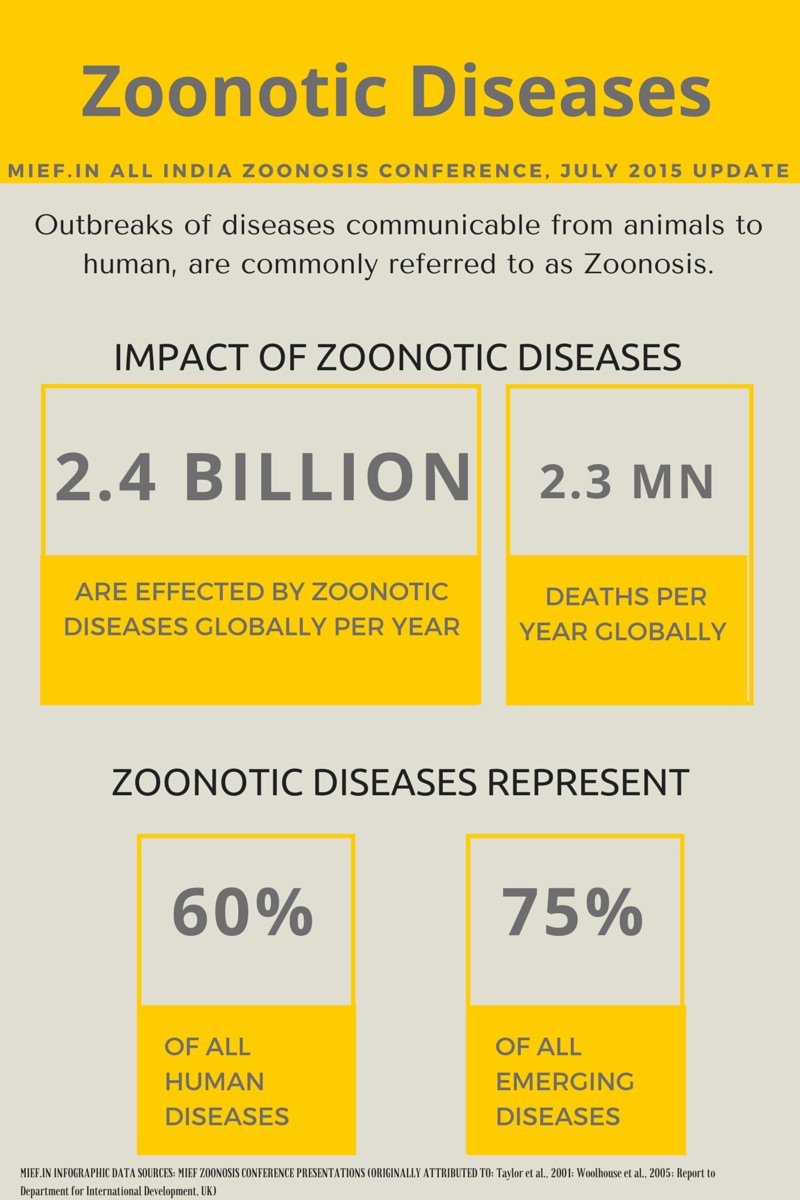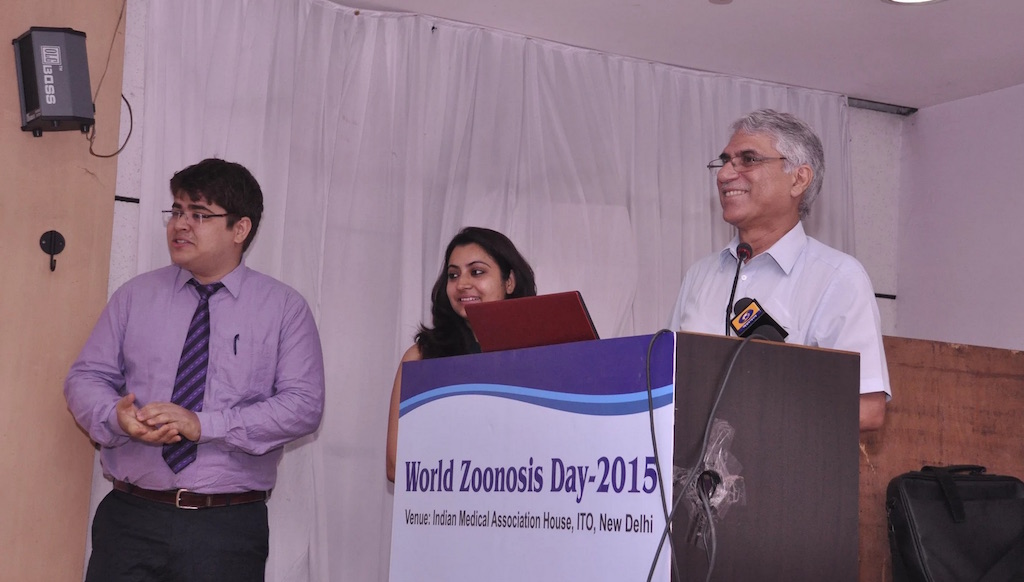Millennium India Education Foundation observed World Zoonosis Day 2015 by hosting the 5th National Conference on Scientific Awareness on Zoonotic Disease Control on July 5, 2015, in Delhi. The conference was held in association with Indian Council of Agriculture Research (Animal Science Division) Ministry of Agriculture & Cooperation Govt. of India, and Heart Care Foundation of India. The MIEF Zoonosis conference was attend by medical professionals and veterinary practitioners from all over India to discuss the impact and studies on this cross-disciplinary issue.
Dr. Uday Kakroo, Director, Millennium India Education Foundation, said that the conference was attended by 130 medical professionals, who discussed and agreed upon ways and measures to prevent various emerging and endemic zoonotic rare medical cases in India to prevent both human, and animal production losses.
Outbreaks of diseases communicable from animals to human, are commonly referred to as Zoonosis. They have been traced to human interaction with animals at fairs, zoos and other settings.
MIEF Zoonosis Conference 2015 Update

Here are the key takeaways from the conference:
- Medical experts from all fields (Veterinarians,Medical and animal owners/breeders) agreed on digital technology serving as a fruitful link between various groups, to increase disease surveillance.
- Zoonoses are important because disease that starts as a zoonosis may have the potential to develop into a major human communicable disease. Many zoonoses are able to cause very significant human morbidity and mortality.
- Zoonosis constitutes nearly 60% of all known human infections and over 75% of all emerging pathogens. Zoonoses are typically endemic and occur in natural foci. Daily 50,000 people die from infectious diseases including “Zoonoses” (WHO).
- Of 1415 human pathogens 868 (61%) originate from animals and many of them have gotten established in humans.
- Of the 175 emerging diseases 132 (75%) are zoonotic. These include threats from rodents-50, dogs-32, cats-30, pigs-26, cattle-22, sheep and goats-16, horses-10, Birds- 20+9 from bats, rabbits, hares, pikas-15, camel-6, elephant-5, fishes-19.
- Man is directly or indirectly involved. Man is recipient as well donor. To prevent cross infection, Social distance between man and other animal species is important
- High risk groups include Infants and small children because of immature immune systems, poor hygiene – hands in mouth, pregnant women, elderly (whose immune systems may be impaired), infants, immuno-compromised people – undergoing cancer therapy, HIV/AIDS Patients, Hepatitis Virus+ve patients, cirrhotic patients, veterinarians, zoo/wildlife/primate and other animal health care workers, agricultural workers, medical practitioners, researchers working on lab animals etc.
- Anthrax, Brucellosis, TB, Q-fever, Leptospirosis, KFD, JE, RSSE, Rabies, RVF, Plague, RKD, Psittacosis-ornithosis, Erysipeloid ,Bird Flu etc are also known as “Occupational Zoonosis”.
- Most common routes of acquiring diseases from animals are:
- Direct or occupational exposure: Every day contact with animals.
- Contaminated soils, environment, food: Through contaminated Milk, meat, fish, poultry or their products ,parasitic infections, handling of carcasses etc.
- Inhalation – Anthrax, TB, Rabies, Bird Flu Influenza, Swine Flu Influenza, Histoplasmosis.
- Animal Bites, Scratches etc. : Rabies, Cat Scratch, Rat Bite fever , Erysipeloid, tetanus(abraded wounds/skin), etc.
- Arthropod vectors: flea-plague, ticks-KFD, Mosquitoes-Japanese Encephalitis, Yersinia Fever, Filaria.
- Intrauterine / transplacental-Toxoplasmosis, Listeria.
- Host Animals responsible for transmission of diseases to human include:
- Farm Animals: Cattle, buffaloes, sheep, goats, swine, cats, dogs, camel, poultry, horses do not spread zoonosis
- Wild Animals: Rats, mice/rodents, squirrels, raccoons, foxes, bats, migratory birds
- Vectors: Mosquitoes, ticks, lice, flea, house flies, insects
- Laboratory animals like guinea pig,rats
- Primates: Monkeys, gorillas

The key speakers at the event, who spoke on different diseases of Zoonotic nature, included:
- Dr Kamaljit Kaur , Buzz for Health, New Delhi: Communication Needs & Continuous Medical Education for Medical & Veterinary Professional Via New Indian App.
- Dr Lal Krishna Ex ADG AH ICAR and Ex AHC GOI on One World on Health: An Overview and Food borne diseases and Food Safety.
- Dr. A.K. Bhatia, Head, Biotechnology and Microbiology and Immunology Department, GLA Univ., Mathura on Overview on Viral Zoonosis with special reference JE, Dengue, Chikungunya, Kyasanur Forest Disease.
- Dr. P.K. Uppal, Advisor Government of Punjab A.H, Dairying and Fisheries Department Chandigarh on Trans -boundary and Emerging viral Zoonotic Diseases, with special reference to SARS corona virus, HIV, Influenza viruses (Swine Flu,Bird Flu ),Mad Cow Disease.
- Dr. C. Bhattacharya Chief Animal Husbandry Officer, A.H.Dept., Govt. of NCT, Delhi on Trans-boundary (International)diseases –Zoonotic Concerns on Nipah Virus Infection, Ebola,Congo Hemorrhagic Fever.
- Dr. Rishendra Verma Ex Joint Director, CADRAD, IVRI, Izatnagar on Bacterial Zoonosis and concerns on tuberculous zoonosis, Shigellosis, Scrub Typhus, Giardiasis, Campylobacteriosis, Leptospirosis.
- Dr. R.K. Bhardwaj Asstt. Prof., VPH, CVSC, Jammu on Non transboundary (Indian States) diseases with special reference on Rabies, FMD, Cow Pox.
- Dr. Sarman Singh, Head, Division of Clinical Microbiology & Molecular Medicine, AIIMS, New Delhi on Bacterial Zoonosis(Common & Uncommon) and General Comment on Medical point of view and concerns on toxoplasmosis.
- Dr.Shoorvir Singh, Principal Scientist & Head, Central Institute for Research on Goats, Mathura on Johne’s disease in animals: A potential public health hazard and emerging zoonotic pathogen.
- Dr. J. S. Sohal, Amity Institute of Microbial Technology, Amity Univ., Jaipur on Presence of Mycobacterium paratuberculosis in milk and its role in human diseases ,Tetanus.
- Dr. R.Somvanshi, Ex. HOD Pathology, IVRI, Izatnagar, UP on Environmental Hazards exposure to Animals due to Climate Change, Global warming, Environmental Pollution- Air,Water, Soil, Nuclear Waste and Radiations Hazards their risk of transmitting infections to human.
- Dr. Ranjan Agrawal Prof. of Pathology Rohilkhand Medical College & Hospital, Bareilly UP on Environmental Hazards – exposure to Humans due Climate Change, Global warming, Environmental Pollution- Air, Water, Soil, Nuclear Waste and Radiations Hazards and their risk of transmitting infections to domestic and pet animals.
- Dr.A.K. Sinha Coordinator Biological Disaster Management Programme , NDMA, New Delhi on Natural Disaster Management –Preparedness and Vet- Med collaboration with reference to Earthquake, flood, famine, radiation and fire. And risk of zoonotic disease outbreaks and their management.
The Zoonosis conference is an annual event and takes place every year in Delhi.
